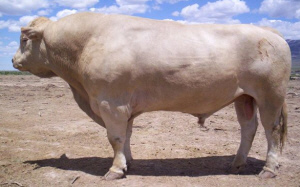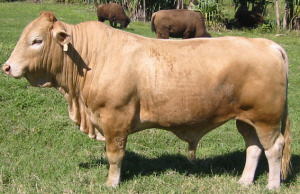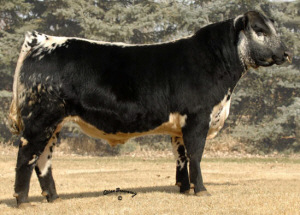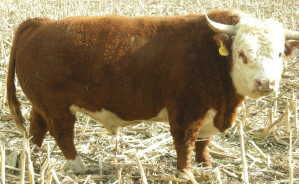



Beefalo
History
Beefalo are a composite cattle breed developed in the United States during the early 1970's by Californian DC "Bud" Basolo by interbreeding American Bison with Domestic Cattle.
The Bison level was set at 3/8th's with the domestic cattle amount 5/8th's.
While interbreeding bison and cattle has been accomplished for some years (Cattalo) the cross often experienced poor fertility.
 Photo courtesy of Paul Butler, Bold Venture LLC, www.boldventure.info |
Also influencing the breed was Montanan Jim Burnett who developed a goodly number of higher bison content bulls used as foundation animals. Such animals with bison content over 3/8th's are classified as Bison Hybrids. Bison Hybrids are often registered by the breed association as "ancestor animals". The minimum amount of bison content an animal may have and still be classified as Beefalo is 17 percent. Beefalo were originally a blend of Hereford and Charolais, but any cattle breed is allowed in their breeding.
Beefalo were extremely popular during the 1970's but fell out of favour primarily due to arguments over proving their Bison content. Blood testing that was available during Beefalo's early years was inexact, and often open to laboratory interpretation. It wasn't until the inception of DNA testing in the 1990's that the breed clearly established itself as having documented bison content.
The reasons for raising Beefalo centre on their handling like domestic cattle while retaining bison traits. Early documentation showed that Beefalo could be finished and marketed at up to 40 percent less cost than a conventional beef animal.
Currently Beefalo are experiencing a renewed interest, due to consumer demand for humane raised all natural, hormone-free and antibiotic-free beef. Beefalo beef is documented to be lower in fat, bad cholesterol, with higher protein than conventional beef. Known for its delicious flavour, Beefalo has won taste tests over regular beef as well as bison. Most Beefalo are marketed directly to consumers at the local level.
For more information on Beefalo visit: www.abwr.org, www.beefaloaustralia.com, www.boldventure.info
Characteristics
The Beefalo can vary greatly in appearance but generally it has a large frame and is well muscled similar in stature to the Bison. They are very docile in nature. One similarity most Beefalos share is their unique coat with it being very dense and made up of fine hair enabling them to adapt to colder climates.
This is why ranchers prefer this breed compared to others, the Beefalo is hardy in extreme cold as well as extreme heat.
Beefalo calves are born small but grow very fast, cattle producers buy and breed Beefalo for the easier care of animals from weaned to sales auction market. The USDA does not allow anyone to sell or claim their meat is Beefalo beef without registration approval from ABWR, so once registered breeders are open to take full advantage of the great beef selling attributes the breed provides.
Statistics
Why raise Beefalo Beef Cattle?
Comparative
 Photo courtesy of Whitsunday Beefalo, www.beefaloaustralia.com |
Beefalo is the only breed that has USDA proven studies on lower fat and lower cholesterol for the meat consumer. Weight Watchers gives only 1 pt for a Beefalo serving, 2 points for beef of other breeds. Doctors also recommend it.
Studies show bison blend beef has great taste, flavour and juiciness. It is lower in bad cholesterol, low in fat and high in protein. Currently there is a trend to DNA test cattle for tenderness. You can have tenderness, but lack flavour and taste. In taste tests conducted by various research groups, Beefalo beef won over regular beef consistently.
Distribution
The Beefalo is produced in the USA and Australia. Increasing numbers of consumers are learning about Beefalo beef and demand is rising, more growers are needed to meet the growing demands for Beefalo meat.
References (the above information was cited from the following sites)
Jonathan Nichols, www.boldventure.info
www.beefaloaustralia.com
www.abwr.org


